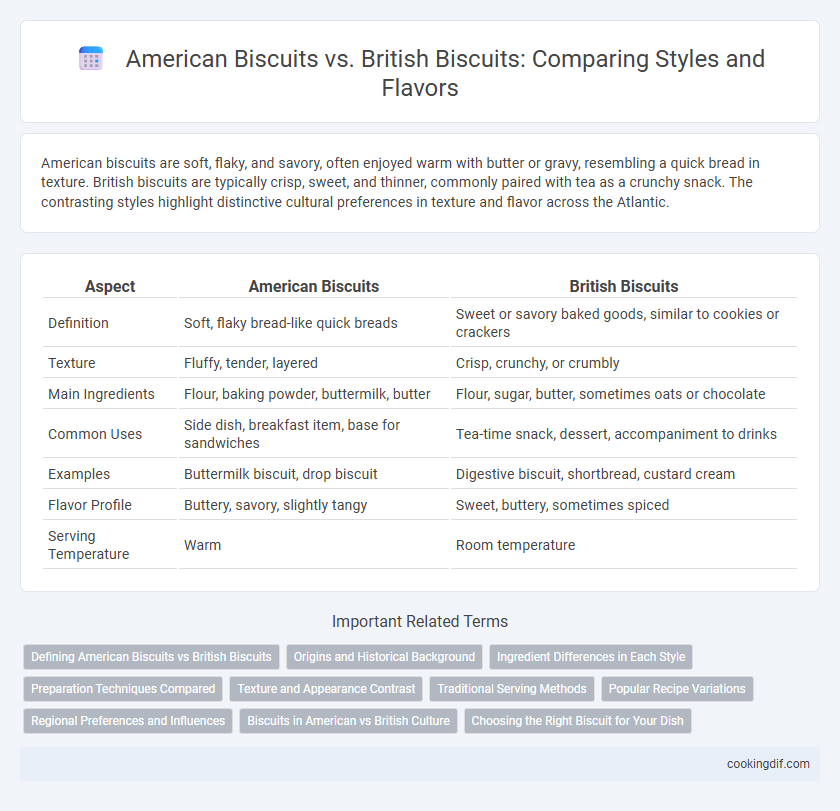American biscuits are soft, flaky, and savory, often enjoyed warm with butter or gravy, resembling a quick bread in texture. British biscuits are typically crisp, sweet, and thinner, commonly paired with tea as a crunchy snack. The contrasting styles highlight distinctive cultural preferences in texture and flavor across the Atlantic.
Table of Comparison
| Aspect | American Biscuits | British Biscuits |
|---|---|---|
| Definition | Soft, flaky bread-like quick breads | Sweet or savory baked goods, similar to cookies or crackers |
| Texture | Fluffy, tender, layered | Crisp, crunchy, or crumbly |
| Main Ingredients | Flour, baking powder, buttermilk, butter | Flour, sugar, butter, sometimes oats or chocolate |
| Common Uses | Side dish, breakfast item, base for sandwiches | Tea-time snack, dessert, accompaniment to drinks |
| Examples | Buttermilk biscuit, drop biscuit | Digestive biscuit, shortbread, custard cream |
| Flavor Profile | Buttery, savory, slightly tangy | Sweet, buttery, sometimes spiced |
| Serving Temperature | Warm | Room temperature |
Defining American Biscuits vs British Biscuits
American biscuits are soft, flaky leavened breads often served savory and similar to scones, while British biscuits refer to crisp, sweet baked goods akin to cookies. The key distinction lies in texture and usage: American biscuits are typically part of a meal, such as breakfast or dinner sides, whereas British biscuits are primarily snacks or accompaniments to tea. Understanding these differences highlights cultural culinary variations between the United States and the United Kingdom.
Origins and Historical Background
American biscuits originated in the Southern United States during the early 19th century, evolving from traditional British scones and emphasizing a soft, flaky texture made with baking powder as a leavening agent. British biscuits trace their roots back to the early medieval period and originally referred to twice-baked bread, ultimately developing into a crisp, sweet, or savory cookie-like treat often enjoyed with tea. The divergence in terminology and style reflects distinct culinary traditions: American biscuits as a leavened bread product essential to Southern cuisine versus British biscuits as a diverse category of baked goods serving as snacks or accompaniments.
Ingredient Differences in Each Style
American biscuits are soft, flaky bread made primarily from flour, baking powder, butter or shortening, and buttermilk, resulting in a savory texture ideal for breakfast or dinner. British biscuits resemble what Americans call cookies, featuring ingredients like sugar, butter, flour, and sometimes chocolate or oats, producing a sweet, crunchy treat. The key ingredient difference lies in American biscuits' leavening agents for rise and softness versus British biscuits' emphasis on sugar and butter for sweetness and crispness.
Preparation Techniques Compared
American biscuits are flaky, soft bread-like products made from dough containing flour, baking powder, butter, and milk, typically prepared by cutting cold butter into the dry ingredients before gently folding in liquids to create layers. British biscuits resemble what Americans call cookies and are baked from a firmer dough with sugar, eggs, and butter creamed together, resulting in a crisp or crunchy texture after baking. The key preparation difference lies in the American biscuit's emphasis on minimal mixing and cold fat to produce tenderness and rise, contrasting with the British method's creaming and thorough mixing to build structure and sweetness.
Texture and Appearance Contrast
American biscuits are soft, flaky, and resemble small, layered bread rolls with a pale golden appearance, offering a tender, crumbly texture ideal for savory accompaniments. British biscuits, on the other hand, are crisp and firm, often sweet, with a smooth, glossy surface ranging from light tan to chocolate brown, providing a crunchy bite perfect for tea-time snacking. The textural contrast lies in American biscuits' pillowy softness versus British biscuits' crisp snap, reflecting distinct culinary traditions and ingredient compositions.
Traditional Serving Methods
American biscuits are traditionally served warm, often split and slathered with butter, honey, or gravy, making them a staple at breakfast and Southern comfort meals. British biscuits are typically crisp or crunchy and enjoyed as a sweet snack alongside tea, emphasizing their role as a teatime treat. The serving styles highlight the American biscuit's soft, bread-like texture contrasted with the British biscuit's biscuit-cake cookie quality.
Popular Recipe Variations
American biscuits commonly feature a flaky, buttery texture achieved through baking powder or baking soda and buttermilk, often served savory alongside dishes like gravy or fried chicken. British biscuits, typically crisp and sweet, range from digestives and shortbread to chocolate-coated varieties, enjoyed as tea-time snacks or dessert accompaniments. Popular American recipe variations include cheddar biscuits and flaky buttermilk biscuits, while British recipes showcase rich vanilla shortbread and spiced ginger nuts.
Regional Preferences and Influences
American biscuits, characterized by their soft, flaky texture and often served warm with butter or gravy, reflect Southern culinary traditions and preferences for savory breakfast items. British biscuits are typically crisp, sweet, and enjoyed as tea-time snacks or desserts, embodying a cultural emphasis on pairing with hot beverages. Regional influences shape these differences, with American biscuits rooted in comfort food practices and British biscuits aligned with social rituals and confectionery history.
Biscuits in American vs British Culture
American biscuits are soft, flaky bread rolls often served warm as a savory side dish, especially in Southern cuisine, while British biscuits refer to sweet, crisp cookies enjoyed with tea. The cultural significance of American biscuits lies in comfort food traditions and hearty meals, contrasting with the British biscuit's role in casual tea times and social rituals. Differences in texture and flavor highlight distinct culinary customs shaped by historical and regional influences in both countries.
Choosing the Right Biscuit for Your Dish
American biscuits, soft and flaky, complement savory dishes like fried chicken and gravy, while British biscuits, crisp and sweet, pair well with tea and desserts. Selecting the right biscuit depends on the dish's flavor profile: choose American biscuits for hearty, comforting meals and British biscuits for light, sugary accompaniments. Understanding these regional differences enhances your culinary experience by matching texture and taste to the occasion.
American biscuits vs British biscuits for style Infographic

 cookingdif.com
cookingdif.com